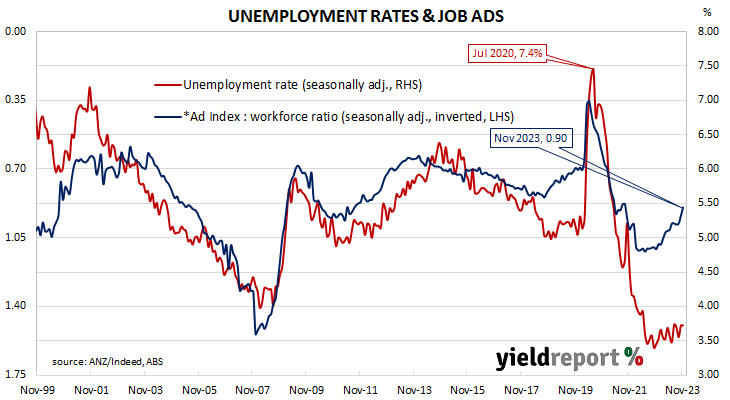Summary: Job ads down 4.6% in November; 16.8% lower than November 2022; ANZ: down 8.4% over last 3 months; ACGB yields fall; rate-rise expectations soften; ANZ: points to further lift in jobless rate; ad index-to-workforce ratio falls.
From mid-2017 onwards, year-on-year growth rates in the total number of Australian job advertisements consistently exceeded 10%. That was until mid-2018 when the annual growth rate fell back markedly. 2019 was notable for its reduced employment advertising and this trend continued into the first quarter of 2020. Advertising plunged in April and May of 2020 as pandemic restrictions took effect but then recovered quite quickly, reaching historically-high levels in 2022.
According to the latest ANZ-Indeed figures, total advertisements fell by 4.6% in November on a seasonally adjusted basis. The result followed losses of 3.5% in October and 0.6% in September. On a 12-month basis, total job advertisements were 16.8% lower than in November 2022, down from October’s revised figure of -11.6%.
“ANZ-Indeed Australian Job Ads has fallen a cumulative 8.4% over the last three months but the series remains very high compared to historical levels,” said ANZ economist Madeline Dunk.
Commonwealth Government bond yields fell on the day, dragged down by large falls of US Treasury yields on Friday night. By the close of business, 3-year and 10-year ACGB yields had both lost 4bps to 4.04% and 4.46% respectively while the 20-year yield finished 5bps lower at 4.75%.
In the cash futures market, expectations regarding further rate rises softened. At the end of the day, contracts implied the cash rate would remain close to the current rate of 4.32% and average 4.33% through December and January but then average 4.385% in February. May 2024 contracts implied a 4.40% average cash rate while August 2024 contracts implied 4.33%, just 1bp more than the current rate.
“The decline in job opportunities highlights that the labour market is cooling, and points to a further lift in the unemployment rate,” Dunk added. “We expect the number of job ads to moderate as the impacts of this tightening cycle continue to show up in the labour market.”
The inverse relationship between job advertisements and the unemployment rate has been quite strong (see below chart), although ANZ themselves called the relationship between the two series into question in early 2019. A higher job advertisement index as a proportion of the labour force is suggestive of lower unemployment rates in the near future while a lower ratio suggests higher unemployment rates will follow. November’s ad index-to-workforce ratio fell from 0.94 to 0.90 after revisions.
In 2008/2009, advertisements plummeted and Australia’s unemployment rate jumped from 4% to nearly 6% over a period of 15 months. When a more dramatic fall in advertisements took place in April 2020, the unemployment rate responded much more quickly.



